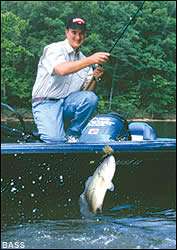
All Bassmaster know the best way to retrieve a Texas rigged plastic worm is the standard lift-and-drop method. They also realize a jig produces best with a slow hop, and that a lipless crankbait run at high speed or with a yo-yo presentation triggers the most strikes.
Stereotype retrieves have developed for standard bass lures throughout the years, but a savvy angler keeps an open mind while using these old reliables. While conventional wisdom calls for the most popular bass lures to be presented in a certain fashion, BASS pros have turned these old standbys into more versatile baits by experimenting with unorthodox retrieves.
"Speed is everything in bass fishing," says Rick Morris, a Bassmaster Tour competitor from Virginia Beach, Va. "The most overlooked speed is burning a bait or ripping it, and a lot of times that's what it takes to get a strike. I can't tell you how many times in my career I have been reeling in a bait slowly, and a fish follows it all the way to the boat but doesn't take it. I make another cast and just rip it, and the fish tears it apart."
Tinkering with retrieves can produce positive results, but the bass' mood still dictates lure presentation. "Fishing baits very fast can be really effective, but you have to know when to do it," advises Morris. "If you are fishing fast when the fish are not chasing, you are not going to catch anything."
When the conventional retrieves fail to spur any action, the BASS touring pros resort to the following unusual applications of some basic bass lures:
Buzzing a grub
The action generated by the single curly tail of a plastic grub makes this lure ideal for swimming steadily at middepth ranges, but it is also effective as a topwater buzzer. "You can burn it right across the top just like a buzzbait," says Morris.
The two time Bassmaster Classic qualifier selects a black-and-blue or junebug Riverside Wooly Curltail for his buzzing grub tactics. He rigs the lure Texas style with a No. 4 or No. 5 Kahle hook (either weightless or with a 1/32- or 1/8-ounce sinker), and ties it on 20-pound-test line. For maximum tail action, Morris makes sure he hooks the grub with its tail pointed downward.
This high-speed technique works best for Morris in the spring and fall, when he keys on shallow vegetation, bushes or spawning flats. "It is awesome around spawning time," suggests Morris. "A lot of times you'll see the wake as the fish comes up to take it. If you do have a fish come up behind it and not take it, just drop the grub down in the cover like a worm. You can't do that with a buzzbait."
The Virginia pro also buzzes the plastic grub over matted vegetation on Northern natural lakes where weedless frogs and rats usually excel. In this situation Morris rigs the grub with a ½-ounce weight and rolls it across the top of the mat. "If you can get a fish to come up and follow it under the mat, then stop the lure over the first available hole and let it fall, you'll have that fish," Morris claims.
Cranking a worm
Veteran BASS pro Guy Eaker departs from the norm by steadily cranking a worm through grass. "All I do is just keep it swimming and moving," says Eaker, who notes that the technique works especially well in areas mixed with thick hydrilla and milfoil.
His swimming worm tactics produce best during prefrontal weather conditions, when bass are most active. After the front passes, Eaker drops the lure into the weeds and relies on the conventional worm retrieve.
The Cherryville, N.C., angler favors a 6- to 8-inch junebug Riverside Ribbontail Worm for his weed tricks. His Texas rigged worm consists of an Eagle Claw HP hook (1/0 for 6-inch worm, and 2/0 for 7- and 8-inch models); and a 1/8-ounce sinker. When fishing sparse cover and clear water, Eaker swims the worm on 10-pound-test line and spinning tackle, but he switches to heavier tackle (7-foot Fenwick baitcast rod, 17- to 20-pound test and 3/0 hook) for working through thick vegetation in Florida waters.
The 10 time Classic qualifier retrieves his worm just fast enough to keep it above the weeds. "All I want to do is have that worm ticking the grass all the time," says Eaker, who occasionally varies his presentation by lifting the worm and reeling it at the same time.
Swimming a lizard
Texas pro Alton Jones discovered this technique by accident one spring. "We had been enjoying a real good lizard bite during the spawn, and it changed overnight," recalls Jones. When the action shut down the next day, Jones noticed he still caught two of his biggest fish while reeling in to make another cast. So, he started slowly reeling in the lure and caught 50 bass that day on the new retrieve.
Jones tries this tactic whenever he fishes an area where he caught bass previously on a jig or other slow moving plastic lure. The Texas pro believes the subtle presentation of a swimming lizard also entices bass that are reluctant to hit crankbaits or spinnerbaits. His favorite time to employ this trick is during the postspawn, when fish remain no deeper than 5 feet.
The 2000 MegaBucks champion chooses a 6- to 7-inch Yum Lizard (cotton candy or junebug) for this clear water tactic. He believes the lizard is ideal for this technique because its curled tails and legs provide more swimming action than a jig or plastic worm. Jones attaches the lure to a 3/0 Gamakatsu wide gap hook, "Texposing the hook point," and selects a 1/16-ounce weight for swimming the lizard in the shallows. Most of the time he cranks the lizard on 17- to 20-pound test, but he scales down to lighter line in the clearer water.
Slow rolling lipless crankbaits
Burning and ripping lipless crankbaits are standard retrieves for taking hot weather bass, but a slow approach with these lures works better in certain situations during winter, spring and fall. Jones alters his retrieve then by slow rolling a Cotton Cordell Rattlin' Spot. "There are times when that makes the difference between getting no bites and getting 20 bites," suggests Jones.
When vegetation growth is at a minimum (less than 1 foot off the bottom) in the spring and fall, Jones slowly cranks the Spot over the weeds. "If you are not feeling the grass, you need to slow down your retrieve, but if you are feeling too much, you need to speed up the lure," recommends Jones, who wants his lure to constantly tick the top of the cover.
Jones retrieves the Spot at about the same speed as slow rolling a spinnerbait. "A lot of times you can feel it (vibrating) in your rod tip, but sometimes you won't even feel the vibration," describes Jones. "You don't want it so slow that it's not moving. You've got to have the side-to-side movement, but it doesn't take a lot to get that action out of the lure."
Depth determines the lure size Jones chooses for slow rolling. He chooses the following sizes for various depth ranges: ¼ ounce for less than 3 feet, ½ ounce for 4 to 6 feet; and ¾ ounce for 7 to 10 feet.
A finesse version of yo-yoing a lipless crankbait works for Jones in the fall and winter along gravel or sandy points. "Instead of ripping it, I gently twitch it off the bottom and then let it do a slow roll and fall back," says Jones, who lifts the lure about 6 inches off the bottom. "I'm almost fishing it like a jig, but every time I'm moving it just fast enough to make that little rattling vibration."
This technique produces for Jones whenever bass continue to ignore faster moving lures such as crankbaits. Jones also employs the retrieve in the spring, when he can run the lure through new vegetation without having to rip it off the cover.
Jig extremes
BASS titleholder Chad Brauer retrieves a jig at about any imaginable speed to catch a bass. On one end of the spectrum, he employs a high-speed retrieve for shallow bass, and on the other, he slowly drags the lure on the bottom for deeper fish.
His high-speed presentation propels the jig faster than the normal swimming retrieve Brauer employs while targeting shallow logs and docks in the fall. "I'm almost working it as fast as a spinnerbait," says Brauer, who tries to keep the lure near the surface. "But I'm still trying to keep a pumping motion and giving the jig a little bit of action."
Sometimes Brauer kills the action of the lure after pulling it over a branch. The jig expert lets the lure fall next to the cover and then jerks it a couple of times to create the erratic action of a fleeing baitfish. He claims this retrieve works especially well for him in areas receiving heavy fishing pressure.
Since the retrieve imitates a fleeing baitfish, Brauer selects jig colors resembling shad. His favorite lure for this high-speed tactic is a ¼- to 3/8-ounce Strike King Denny Brauer Design Pro-Model jig in white or chartreuse/ white. In most situations, he tips the jig with a large white pork chunk, which he believes gives the lure a bigger profile and more buoyancy than plastic trailers. Brauer scales down to a shorter pork frog when fishing tidal rivers or other waters containing smaller baitfish. The Missouri pro also occasionally switches to a twin-tail plastic grub as a jig trailer to increase the lure's action.
Dancing a jig around laydowns and docks requires heavy tackle, so Brauer uses thick line and a Team Daiwa Denny Brauer Flipping and Pitching Stick. When retrieving the jig in clear water, Brauer uses 20-pound-test line, but most of the time he ties his lure on green Stren 25-pound test. Brauer uses the same high-speed reel (Team Daiwa TD-X103HVA with 6.3:1 gear ratio) for both fast and slow jig presentations. "I just feel like you can mentally slow yourself down with a fast reel, but you can only physically crank so fast with a slow reel," he says.
Crawling a jig along the bottom is Brauer's slowest retrieve. Similar to dragging a Carolina rig, this presentation keeps the jig in constant contact with the bottom. "It seems to work real well in the early spring and summer, where the fish are a little bit deeper, not quite as active and are strictly feeding on crawfish," says Brauer.
Keeping his rod tip parallel to the water, Brauer steadily reels in the jig rather than employing the rod-sweeping retrieve frequently used for Carolina rigs. "That keeps me in contact with the bait and the bottom all the time, and I can still accomplish the same stop-and-go retrieve (of a Carolina rig presentation)," says Brauer.
The Missouri angler opts for a ½- to ¾-ounce Strike King Denny Brauer Design Pro-Model Jig for this bottom-banging tactic. Since this is mainly a clear water tactic, Brauer selects natural hues, such as watermelon, green pumpkin and chameleon crawfish, for both his jig and trailer. He picks a pork frog for his trailer in the early spring and switches to a twin-tail plastic grub during the summer. His tackle for this tactic consists of a Team Daiwa 7-foot, 3-inch Jigging Rod, and the Team Daiwa baitcast reel spooled with 15- to 17-pound-test line. In ultraclear water, he scales down to 10- to 12-pound line.
Relying on stereotypical retrieves of our favorite bass lures frequently pays off, but Alton Jones suggests straying from the ordinary presentations to discover the full potential of these baits. "If things quit happening for you, you need to experiment with these different retrieves, and you'll become successful."

